Boyle J.A. The Cambridge History of Iran, Volume 5: The Saljuq and Mongol Periods
Подождите немного. Документ загружается.

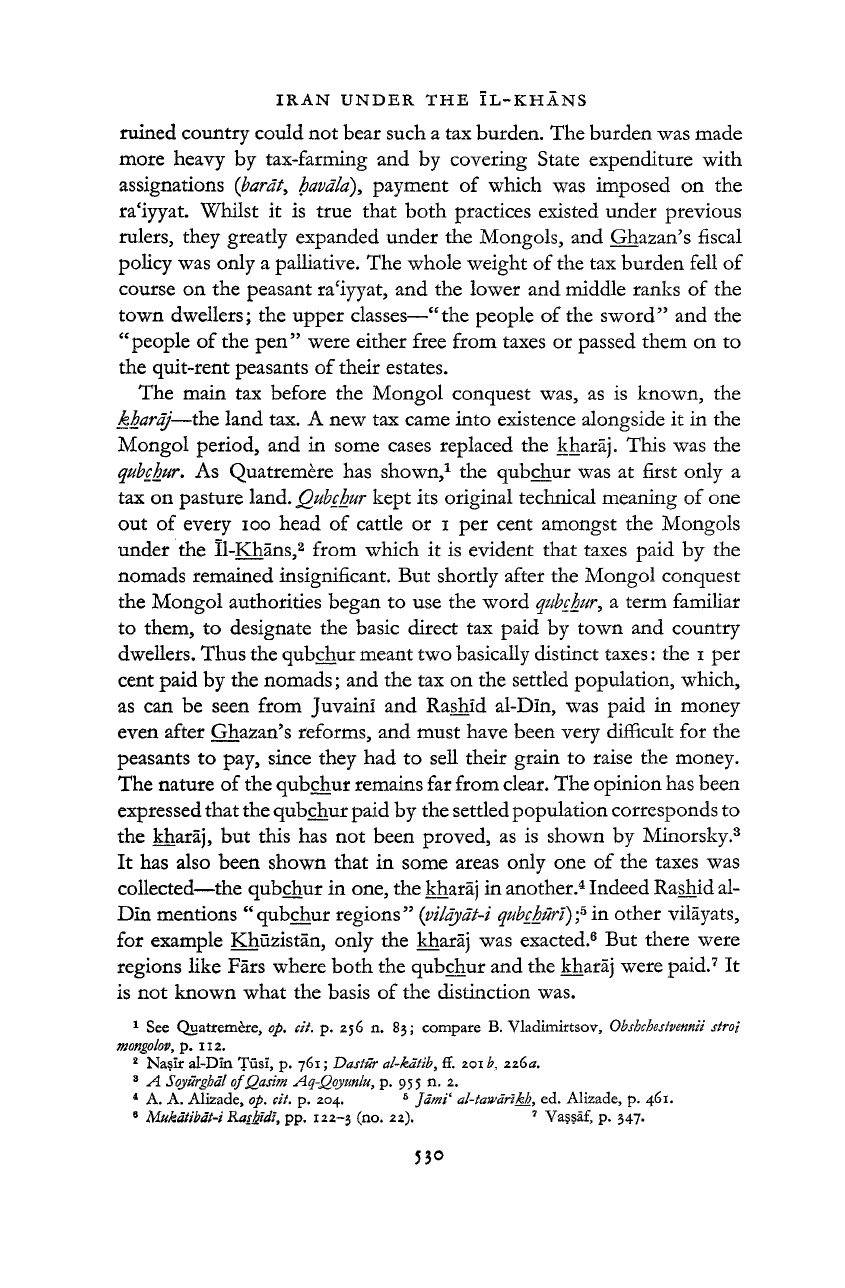
IRAN UNDER THE IL-KHANS
530
ruined country could not bear such a tax burden. The burden was made
more heavy by tax-farming and by covering State expenditure with
assignations (bardt, havala), payment of which was imposed on the
ra'iyyat. Whilst it is true that both practices existed under previous
rulers, they greatly expanded under the Mongols, and Ghazan's fiscal
policy was only a palliative. The whole weight of the tax burden fell of
course on the peasant ra
c
iyyat, and the lower and middle ranks of the
town dwellers; the upper classes—"the people of the sword" and the
"people of the pen" were either free from taxes or passed them on to
the quit-rent peasants of their estates.
The main tax before the Mongol conquest was, as is known, the
kharaj—the land tax. A new tax came into existence alongside it in the
Mongol period, and in some cases replaced the kharaj. This was the
qubchur. As Quatremere has shown,
1
the qubchur was at first only a
tax on pasture land. Qubchur kept its original technical meaning of one
out of every 100 head of cattle or i per cent amongst the Mongols
under the Il-Khans,
2
from which it is evident that taxes paid by the
nomads remained insignificant. But shortly after the Mongol conquest
the Mongol authorities began to use the word
qubchur,
a term familiar
to them, to designate the basic direct tax paid by town and country
dwellers. Thus the qubchur meant two basically distinct taxes: the i per
cent paid by the nomads; and the tax on the settled population, which,
as can be seen from Juvaini and Rashid al-Dln, was paid in money
even after Ghazan's reforms, and must have been very difficult for the
peasants to pay, since they had to sell their grain to raise the money.
The nature of the qubchur remains far from clear. The opinion has been
expressed that the qubchur paid by the settled population corresponds to
the kharaj, but this has not been proved, as is shown by Minorsky.
3
It has also been shown that in some areas only one of the taxes was
collected—the qubchur in one, the kharaj in another.
4
Indeed Rashid al-
Din mentions " qubchur regions "
(vildydt~i qubchur!)
;
5
in other vilayats,
for example Khuzistan, only the kharaj was exacted.
6
But there were
regions like Fars where both the qubchur and the
kharaj were paid.
7
It
is not known what the basis of the distinction was.
1
See Quatremere, op. cit. p. 256 n. 83; compare B. Vladimirtsov,
Obshchestvennii
stroi
mongolov,
p. 112.
2
Naslr al-Din Tusi, p. 761; Dastur al-kdtib, ff. 201 b, 226a.
3
A Soyurghdlof Qasim Aq-Qoyunlu, p. 955 n. 2.
4
A. A. Alizade, op. cit. p. 204.
6
]dmi
c
al-tawdrikh>
ed. Alizade, p. 461.
6
Mukdtibdt-i Rasbidi, pp. 122-3 (no. 22).
7
Vassaf, p. 347.
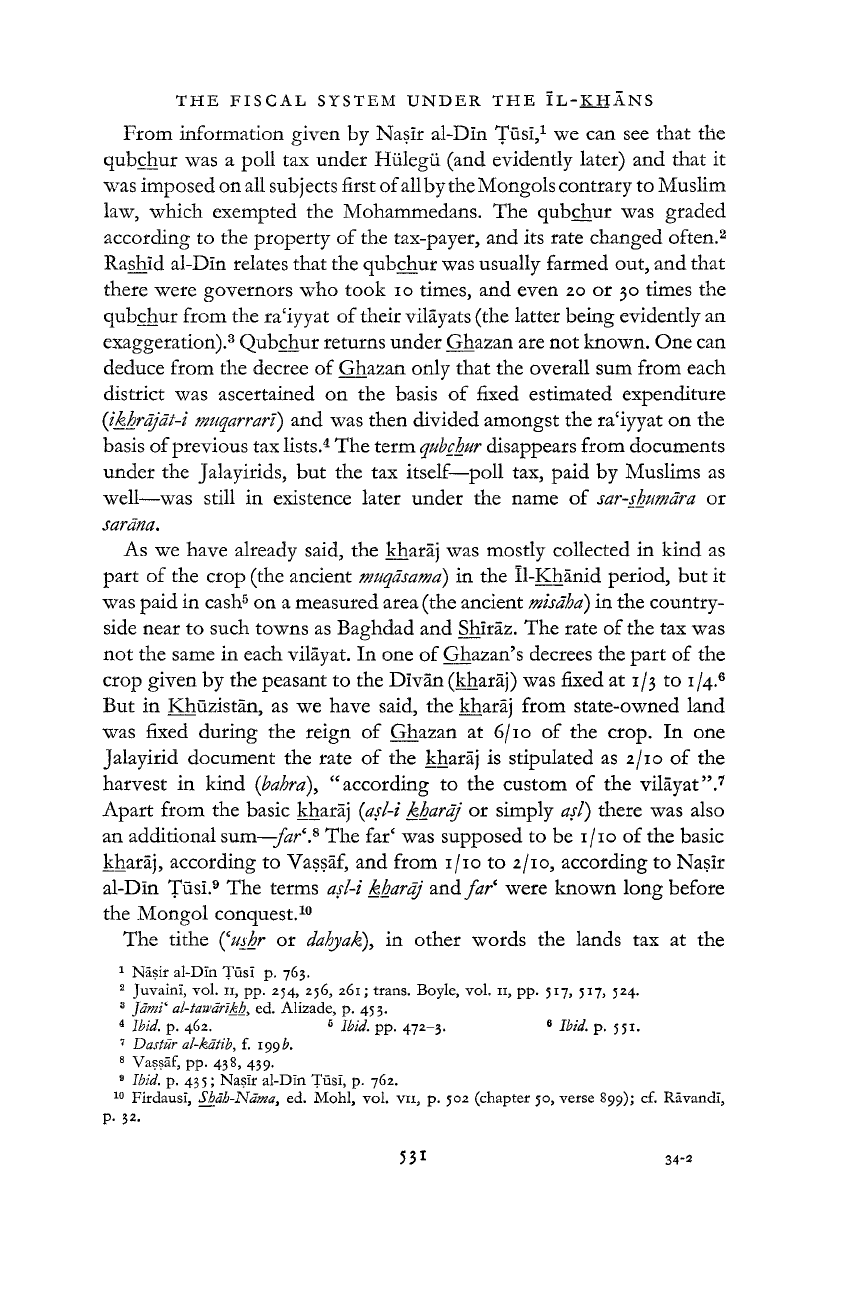
THE FISCAL SYSTEM UNDER THE İL-KHÂNS
34-2
From information given by Naşir al-Din Tüsi,
1
we can see that the
qubchur was a poll tax under Hülegü (and evidently later) and that it
was imposed on all subjects first of all by the Mongols contrary to Muslim
law, which exempted the Mohammedans. The qubchur was graded
according to the property of the tax-payer, and its rate changed often.
2
Rashid al-Din relates that the qubchur was usually farmed out, and that
there were governors who took i o times, and even 20 or 30 times the
qubchur from the ra'iyyat of their vilâyats (the latter being evidently an
exaggeration).
3
Qubchur returns under Ghazan are not known. One can
deduce from the decree of Ghazan only that the overall sum from each
district was ascertained on the basis of fixed estimated expenditure
{ikhrâjât-i
muqarrarT)
and was then divided amongst the ra'iyyat on the
basis of previous tax lists.
4
The term
qubchur
disappears from documents
under the Jalayirids, but the tax itself—poll tax, paid by Muslims as
well—was still in existence later under the name of
sar-shumara
or
sarana.
As we have already said, the kharâj was mostly collected in kind as
part of the crop (the ancient
muqdsama)
in the Il-Khanid period, but it
was paid in cash
5
on a measured area (the ancient
misâha)
in the country-
side near to such towns as Baghdad and Şhirâz. The rate of the tax was
not the same in each vilâyat. In one of Ghazan's decrees the part of the
crop given by the peasant to the Divân (kharâj) was fixed at 1/3 to
1
/4.
6
But in Khüzistân, as we have said, the kharâj from state-owned land
was fixed during the reign of Ghazan at 6/10 of the crop. In one
Jalayirid document the rate of the kharâj is stipulated as 2/10 of the
harvest in kind (bahra), "according to the custom of the vilâyat".
7
Apart from the basic kharâj {asl-i kharâj or simply aşl) there was also
an additional sum—far\
8
The far' was supposed to be 1/10 of the basic
kharâj,
according to Vaşşâf, and from 1/10 to 2/10, according to Naşir
al-Din Tüsi.
9
The terms aşl-i kharâj and far
6
were known long before
the Mongol conquest.
10
The tithe Çuşhr or dabyak), in other words the lands tax at the
1
Naşir al-Dîn Tüsi p. 763.
2
Juvainî, vol. 11, pp. 254, 256, 261; trans. Boyle, vol. 11, pp. 517, 517, 524.
3
J ami
1
al-tawdrikh)
ed. Alizade, p. 453.
4
Ibid. p. 462.
5
Ibid. pp. 472-3.
6
Ibid. p. 551.
7
Dastür al-kâtib, f. 199^.
8
Vaşşâf, pp. 438, 439.
9
Ibid. p. 435; Naşir al-Dîn Tüsî, p. 762.
10
Firdausî, Shâb-Nâma, ed. Mohl, vol. vn, p. 502 (chapter 50, verse 899); cf. RâvandI,
p.
32.
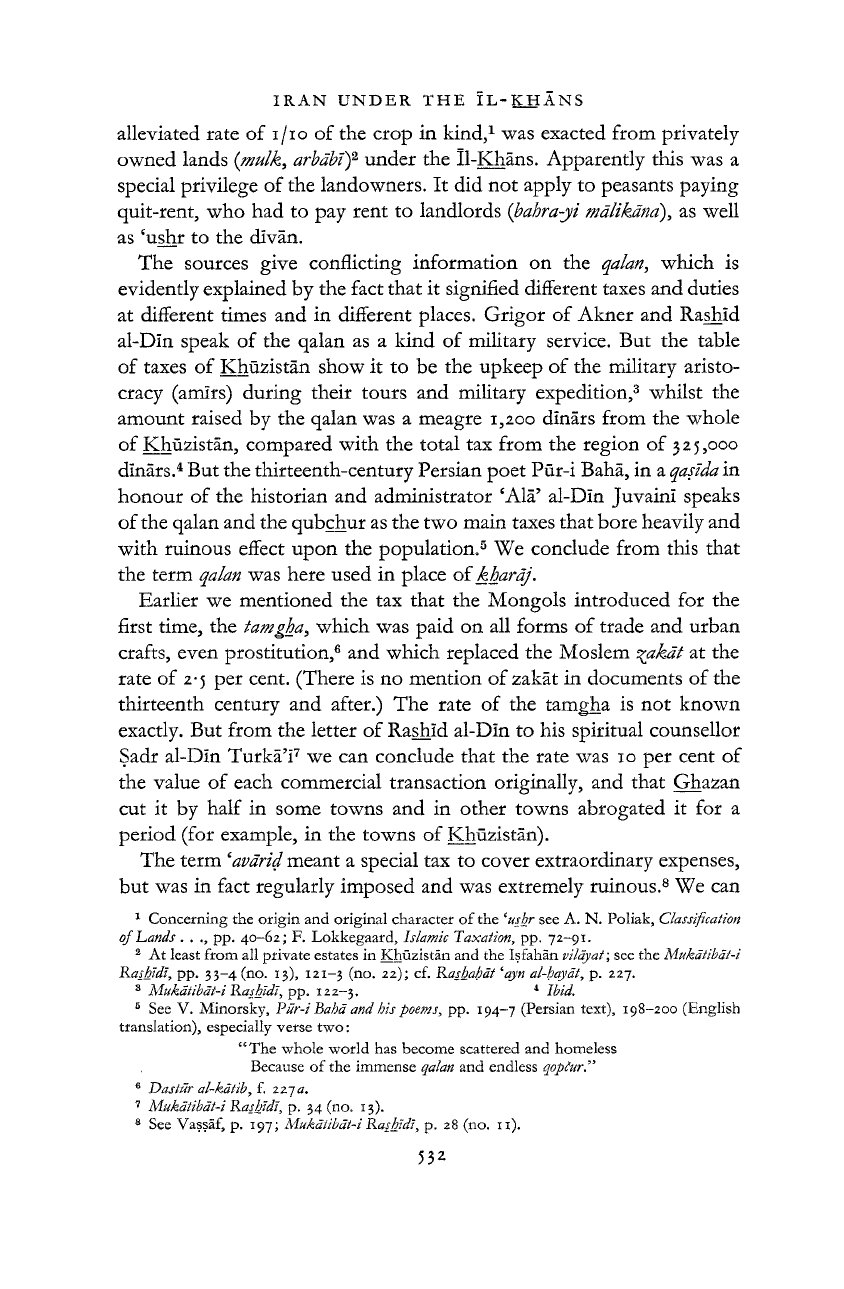
IRAN UNDER THE IL- KHANS
532
alleviated rate of i/10 of the crop in kind,
1
was exacted from privately
owned lands
(mulk>
arbdbt)
2
under the Il-Khans. Apparently this was a
special privilege of the landowners. It did not apply to peasants paying
quit-rent, who had to pay rent to landlords {bahra-ji mdlikdna), as well
as 'ushr to the divan.
The sources give conflicting information on the
qalan>
which is
evidently explained by the fact that it signified different taxes and duties
at different times and in different places. Grigor of Akner and Rashid
al-Dln speak of the qalan as a kind of military service. But the table
of taxes of Khuzistan show it to be the upkeep of the military aristo-
cracy (amirs) during their tours and military expedition,
3
whilst the
amount raised by the qalan was a meagre 1,200 dinars from the whole
of Khuzistan, compared with the total tax from the region of 325,000
dinars.
4
But the thirteenth-century Persian poet Pur-i Baha, in a
qasida
in
honour of the historian and administrator
c
Ala' al-Dln Juvaini speaks
of the qalan and the qubchur as the two main taxes that bore heavily and
with ruinous effect upon the population.
5
We conclude from this that
the term
qalan
was here used in place of khardj.
Earlier we mentioned the tax that the Mongols introduced for the
first time, the
tamgha>
which was paid on all forms of trade and urban
crafts,
even prostitution,
6
and which replaced the Moslem
%akdt
at the
rate of 2-5 per cent. (There is no mention of zakat in documents of the
thirteenth century and after.) The rate of the tamgha is not known
exactly. But from the letter of Rashid al-Dln to his spiritual counsellor
Sadr al-Din Turka'i
7
we can conclude that the rate was 10 per cent of
the value of each commercial transaction originally, and that Ghazan
cut it by half in some towns and in other towns abrogated it for a
period (for example, in the towns of Khuzistan).
The term
'avdrid
meant a special tax to cover extraordinary expenses,
but was in fact regularly imposed and was extremely ruinous.
8
We can
1
Concerning the origin and original character of the
l
mhr see A. N. Poliak, Classification
of Lands . . pp. 40-62; F. Lokkegaard, Islamic Taxation, pp. 72-91.
2
At least from all private estates in Khuzistan and the Isfahan pi lay at; see the Mukdtibdt-i
Rashidi, pp. 33-4 (no. 13), 121-3 (no. 22); cf. Rashahdt
*՝ayn
al-hayat,
p. 227.
3
Mukdtibdt-i Rashidi, pp. 122-3.
4
Ibid.
5
See V. Minorsky, PHr-i Bahd and his poems, pp. 194-7 (Persian text), 198-200 (English
translation), especially verse two:
"The whole world has become scattered and homeless
Because of the immense qalan and endless qopfar."
6
Dastur al-kdtib, f. 227^.
7
Mukdtibat-i Rashldl, p. 34 (no. 13).
8
See Vassaf, p. 197; Mukdtibdt-i Rashidi, p. 28 (no. 11).
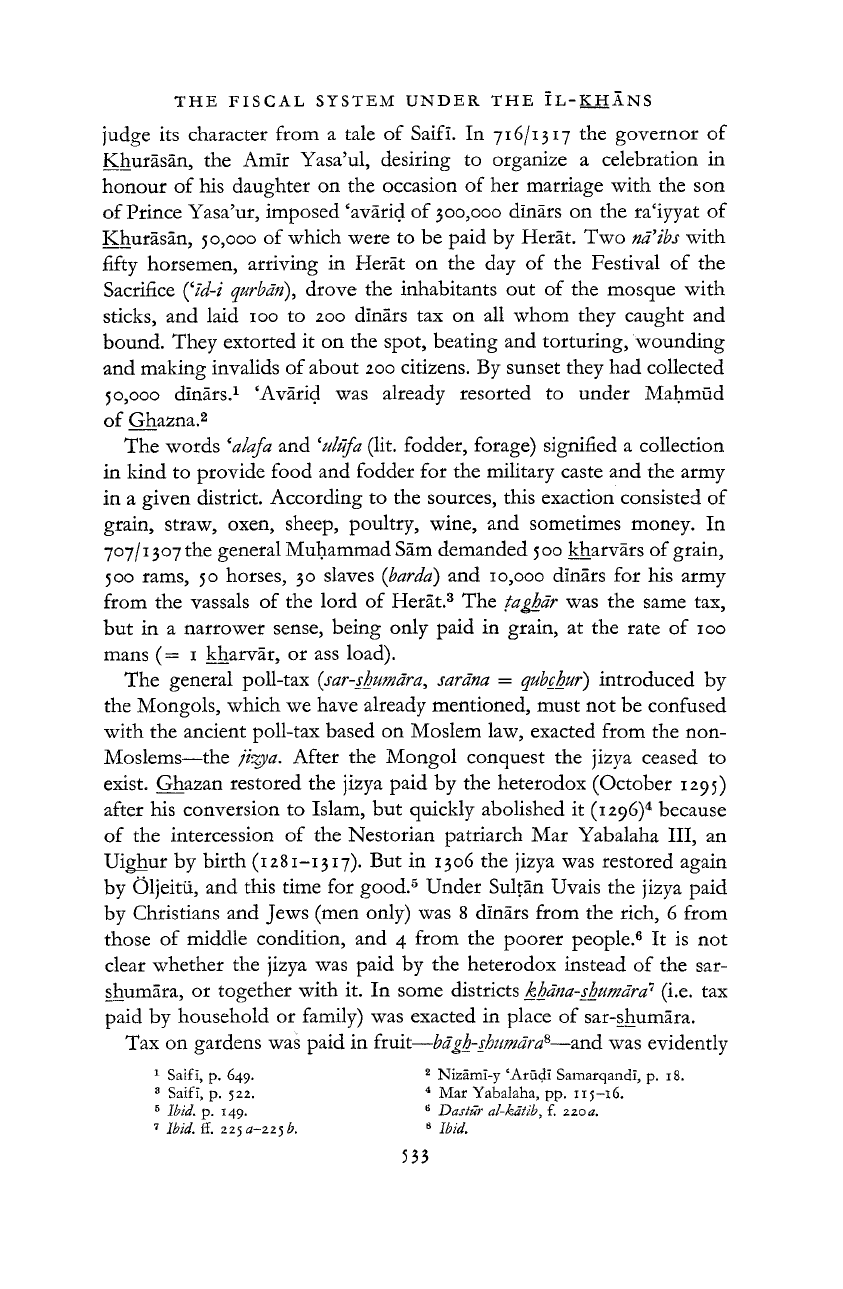
THE FISCAL SYSTEM UNDER THE ÏL-KHÂNS
judge its character from a tale of Saifi. In 716/1317 the governor of
Khurasan, the Amir Yasa'ul, desiring to organize a celebration in
honour of his daughter on the occasion of her marriage with the son
of Prince Yasa'ur, imposed 'avarid of 300,000 dinars on the ra'iyyat of
Khurasan, 50,000 of which were to be paid by Herat. Two naibs with
fifty horsemen, arriving in Herat on the day of the Festival of the
Sacrifice
(
c
zd-i
qurbdn),
drove the inhabitants out of the mosque with
sticks,
and laid 100 to 200 dinars tax on all whom they caught and
bound. They extorted it on the spot, beating and torturing, wounding
and making invalids of about 200 citizens. By sunset they had collected
50,000 dinars.
1
'Avarid was already resorted to under Mahmud
of Ghazna.
2
The words
c
alafa and 'ulufa (lit. fodder, forage) signified a collection
in kind to provide food and fodder for the military caste and the army
in a given district. According to the sources, this exaction consisted of
grain, straw, oxen, sheep, poultry, wine, and sometimes money. In
707/1307 the general Muhammad Sam demanded 500 kharvars of grain,
500 rams, 50 horses, 30 slaves
{barda)
and 10,000 dinars for his army
from the vassals of the lord of Herat.
3
The taghdr was the same tax,
but in a narrower sense, being only paid in grain, at the rate of 100
mans (=1 kharvar, or ass load).
The general poll-tax
(sar-shumdra
y
sardna — qubchur) introduced by
the Mongols, which we have already mentioned, must not be confused
with the ancient poll-tax based on Moslem law, exacted from the non-
Moslems—the jizya. After the Mongol conquest the jizya ceased to
exist. Ghazan restored the jizya paid by the heterodox (October 1295)
after his conversion to Islam, but quickly abolished it (1296)
4
because
of the intercession of the Nestorian patriarch Mar Yabalaha III, an
Uighur by birth (1281-1317). But in 1306 the jizya was restored again
by Oljeitu, and this time for good.
5
Under Sultan Uvais the jizya paid
by Christians and Jews (men only) was 8 dinars from the rich, 6 from
those of middle condition, and 4 from the poorer people.
6
It is not
clear whether the jizya was paid by the heterodox instead of the sar-
shumara, or together with it. In some districts khana-shumdra
1
(i.e. tax
paid by household or family) was exacted in place of sar-shumara.
Tax on gardens was paid in fruit—bdgh-shumdra
8
—and was evidently
1
Saifi, p. 649.
2
Nizami-y 'Arudi Samarqandi, p. 18.
3
Saifi, p. 522.
4
Mar Yabalaha, pp. 115-16.
5
Ibid. p. 149.
6
Dastur al-kdtib, f. 2200.
7
Ibid. ff. 225
#-225
b.
8
Ibid.
533
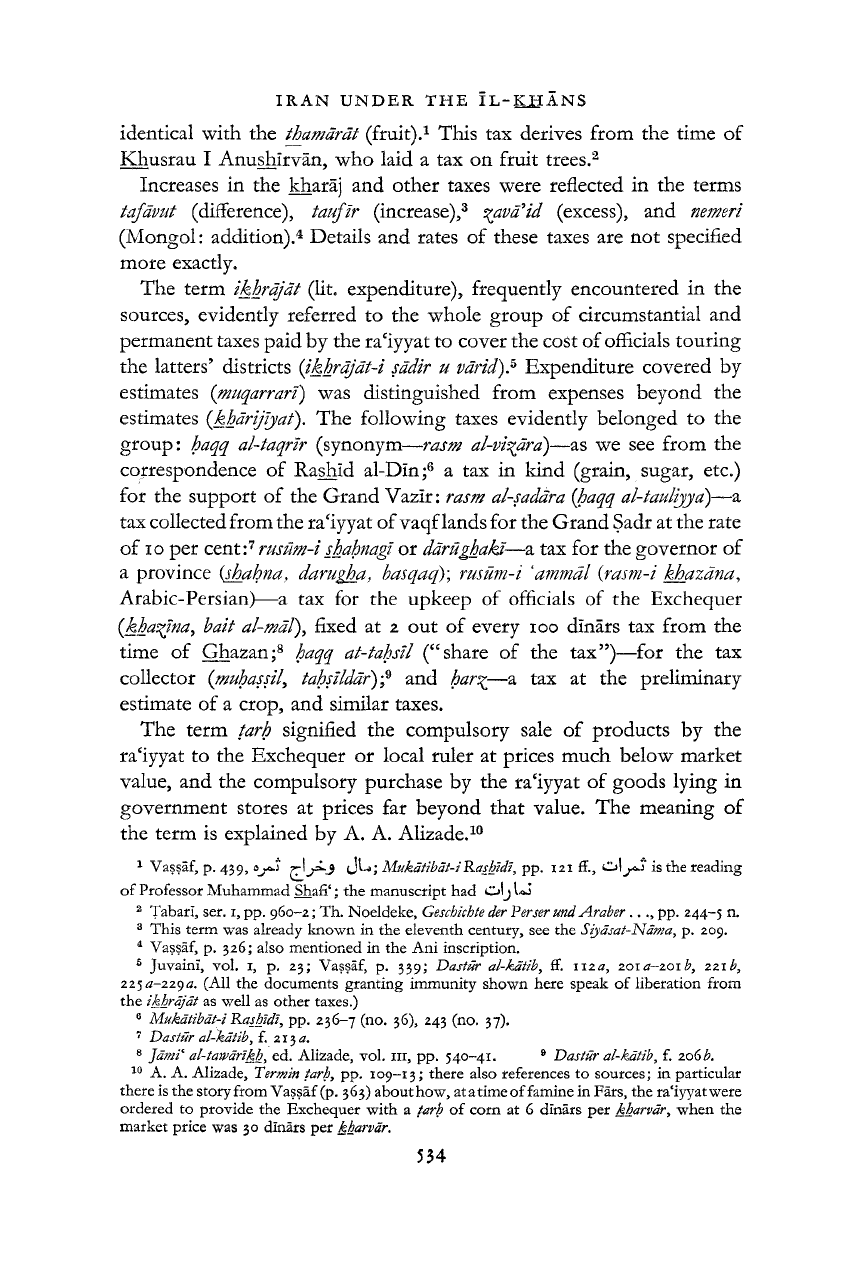
IRAN UNDER THE ĪL-OJĀNS
534
identical with the thamārāt (fruit).
1
This tax derives from the time of
Khusrau I Anushirvān, who laid a tax on fruit trees.
2
Increases in the kharāj and other taxes were reflected in the terms
tafdvut (difference), taufīr (increase),
3
jāvaid (excess), and nemeri
(Mongol: addition).
4
Details and rates of these taxes are not specified
more exactly.
The term ikhrājāt (lit. expenditure), frequently encountered in the
sources, evidently referred to the whole group of circumstantial and
permanent taxes paid by the ra'iyyat to cover the cost of officials touring
the latters' districts (tkhrājāt-i sādir u vārid)? Expenditure covered by
estimates (rnuqarrari) was distinguished from expenses beyond the
estimates (kharifiyat). The following taxes evidently belonged to the
group: haqq al-taqrlr (synonym—rasm al-vi%ara)—as we see from the
correspondence of Rashid al-Dln;
6
a tax in kind (grain, sugar, etc.)
for the support of the Grand Vazīr: rasm
al-sadara {haqq
al-tauliyja)—a
tax collected from the ra'iyyat of vaqf lands for the Grand Sadr at the rate
of 10 per cent:
7
rusūm-i shahnagī
or dārūghakī—a tax for the governor of
a province (shahna, dar
ugha, basqaq); rusūm-i 'ammāl (rasm-i khazāna,
Arabic-Persian)—a tax for the upkeep of officials of the Exchequer
(kharim, bait
al֊māl),
fixed at z out of every 100 dinars tax from the
time of Ghazan;
8
haqq at-tahsīl ("share of the tax")—for the tax
collector (muhassi/,
tahsīldār)
;
9
and har%—a tax at the preliminary
estimate of a crop, and similar taxes.
The term tarh signified the compulsory sale of products by the
ra'iyyat to the Exchequer or local ruler at prices much below market
value, and the compulsory purchase by the ra'iyyat of goods lying in
government stores at prices far beyond that value. The meaning of
the term is explained by A. A. Alizade.
10
1
Vassāf, p. 439,
e>j^-'i
ŗŗ\j**J J^; Mukātibāt-iRashidi, pp. 121 ff., oij^i* is the reading
of Professor Muhammad Shafi'; the manuscript had olj LJ
2
Tabarl, ser. 1, pp. 960-2; Th. Noeldeke,
Geschichte der
Perser und Araber..pp. 244-5 n.
3
This term was already known in the eleventh century, see the
Siyāsat֊Nāma
y
p. 209.
4
Vassāf, p. 326; also mentioned in the Ani inscription.
5
Juvainī, vol. 1, p. 23; Vassāf, p. 339; Dastūr al-kdtib, ff.
112*7,
201
¿7-201
b,
zzib,
2250-2290. (All the documents granting immunity shown here speak of liberation from
the ikhrājāt as well as other taxes.)
6
Mukātibāt-i Rashidi, pp. 236-7 (no. 36), 243 (no. 37).
7
Dastur al-kātib, f. 2130.
8
Jdt»t
c
al-taiPārlkh, ed. Alizade, vol. 111, pp. 540-41.
9
Dastūr al-kātib, f. 206b.
10
A. A. Alizade, Termin tarh, pp. 109-13; there also references to sources; in particular
there is the story from Vassāf
(p.
363) about how, at
a
time of famine in Fārs, the ra'iyyatwere
ordered to provide the Exchequer with a tarh of corn at 6 dinars per kharvār, when the
market price was 30
dinārs per kharvār.
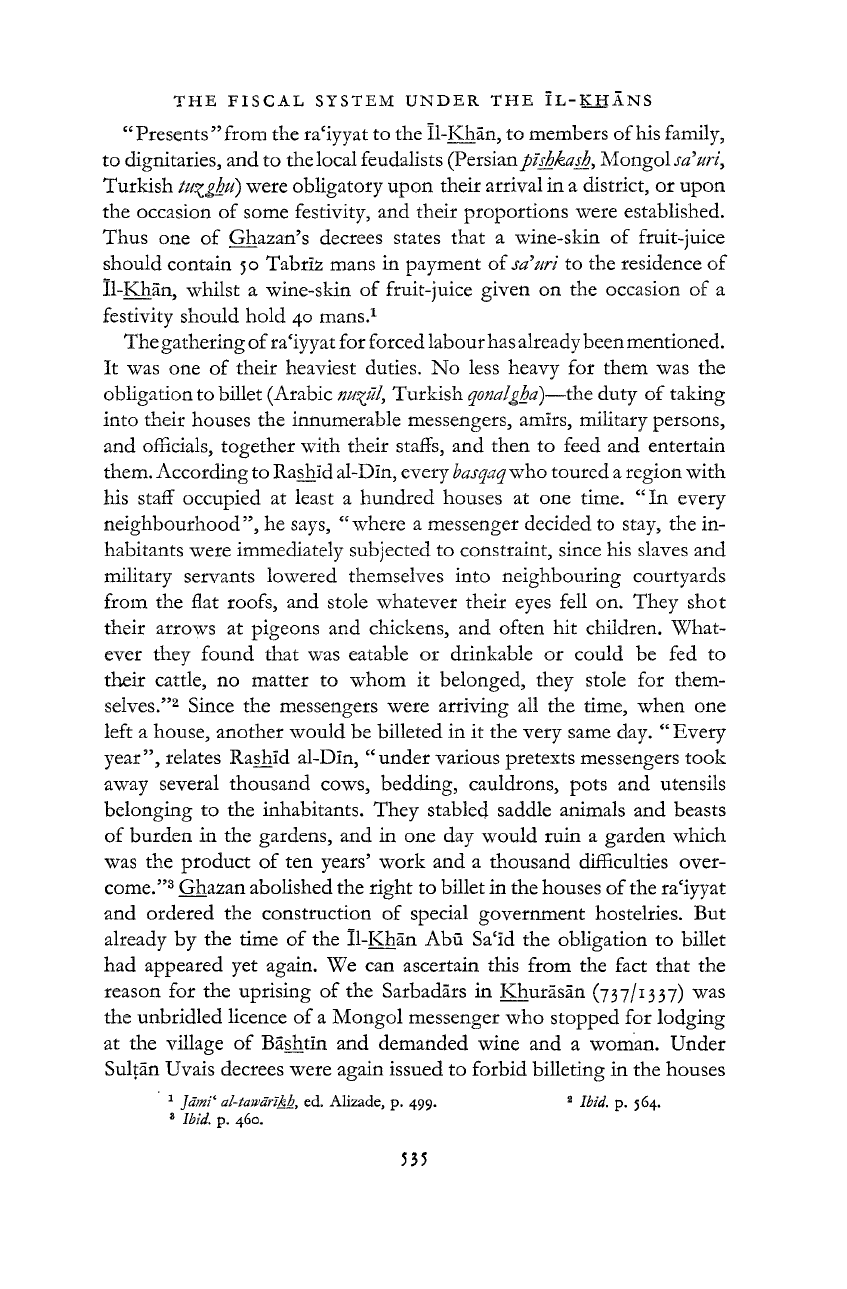
THE FISCAL SYSTEM UNDER THE IL-KHANS
535
"Presents "from the ra'iyyat to the Il-Khan, to members of his family,
to dignitaries, and to the local feudalists (Persianptshkash, Mongol sa'uri,
Turkish
tu^ghit)
were obligatory upon their arrival in a district, or upon
the occasion of some festivity, and their proportions were established.
Thus one of Ghazan's decrees states that a wine-skin of fruit-juice
should contain 50 Tabriz mans in payment of scfuri to the residence of
Il-Khan, whilst a wine-skin of fruit-juice given on the occasion of a
festivity should hold 40 mans.
1
The gathering of ra'iyyat for forced labour has already been mentioned.
It was one of their heaviest duties. No less heavy for them was the
obligation to billet (Arabic
nu%fil>
Turkish qonalgha)—the duty of taking
into their houses the innumerable messengers, amirs, military persons,
and officials, together with their staffs, and then to feed and entertain
them. According to Rashid al-Din, every
basqaq
who toured a region with
his staff occupied at least a hundred houses at one time. "In every
neighbourhood", he says, " where a messenger decided to stay, the in-
habitants were immediately subjected to constraint, since his slaves and
military servants lowered themselves into neighbouring courtyards
from the flat roofs, and stole whatever their eyes fell on. They shot
their arrows at pigeons and chickens, and often hit children. What-
ever they found that was eatable or drinkable or could be fed to
their cattle, no matter to whom it belonged, they stole for them-
selves."
2
Since the messengers were arriving all the time, when one
left a house, another would be billeted in it the very same day. " Every
year", relates Rashid al-Din, "under various pretexts messengers took
away several thousand cows, bedding, cauldrons, pots and utensils
belonging to the inhabitants. They stabled saddle animals and beasts
of burden in the gardens, and in one day would ruin a garden which
was the product of ten years' work and a thousand difficulties over-
come."
3
Ghazan abolished the right to billet in the houses of the ra'iyyat
and ordered the construction of special government hostelries. But
already by the time of the Il-Khan Abu. Sa'id the obligation to billet
had appeared yet again. We can ascertain this from the fact that the
reason for the uprising of the Sarbadars in Khurasan (737/1337) was
the unbridled licence of a Mongol messenger who stopped for lodging
at the village of Bashtin and demanded wine and a woman. Under
Sultan Uvais decrees were again issued to forbid billeting in the houses
1
J
ami*
al-tawarikh, ed. Alizade, p. 499.
2
Ibid. p. 564.
8
Ibid. p. 460.
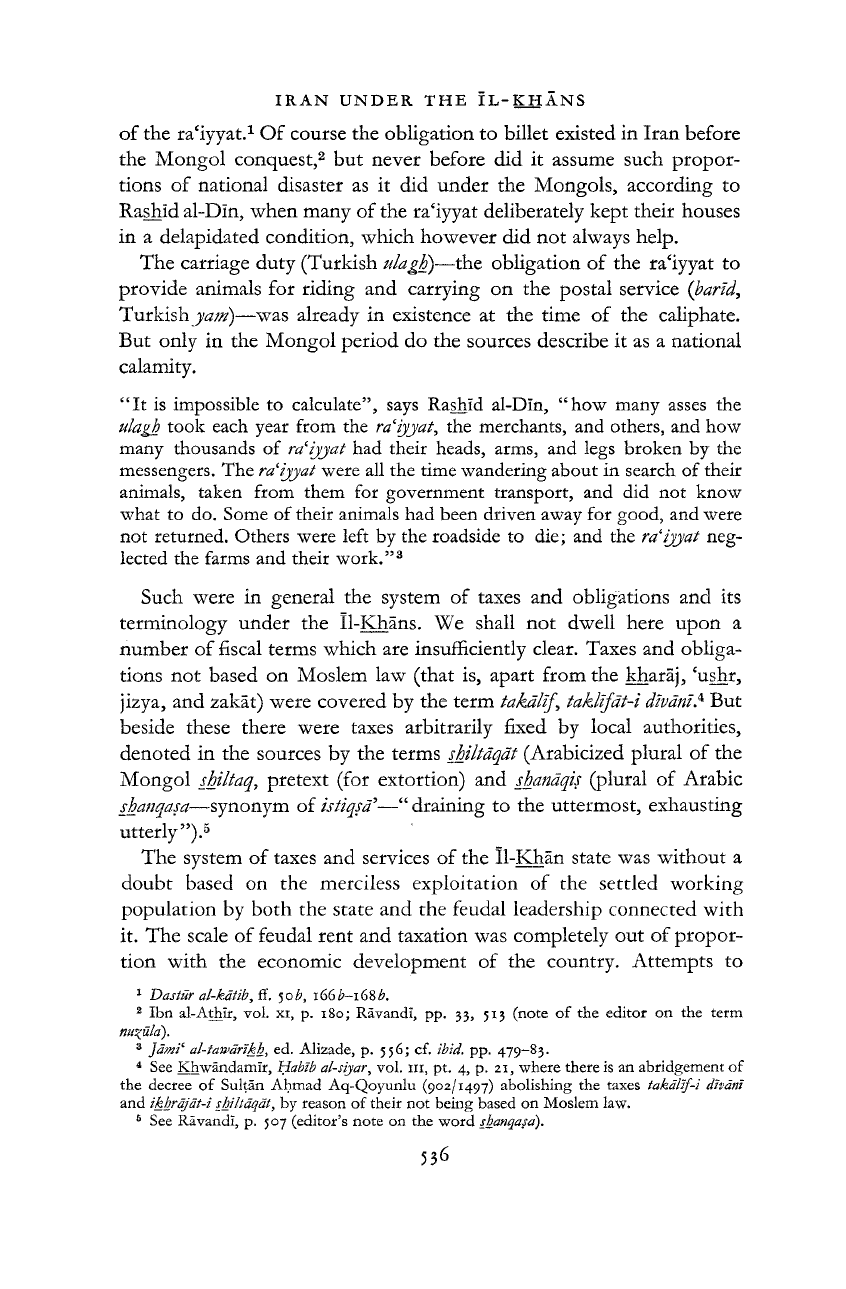
IRAN UNDER THE ÎL-KHÂNS
536
of the ra'iyyat.
1
Of course the obligation to billet existed in Iran before
the Mongol conquest,
2
but never before did it assume such propor-
tions of national disaster as it did under the Mongols, according to
Raşhid al-Din, when many of the ra'iyyat deliberately kept their houses
in a delapidated condition, which however did not always help.
The carriage duty (Turkish ulagh)—the obligation of the ra'iyyat to
provide animals for riding and carrying on the postal service (band,
Turkish yam)—was already in existence at the time of the caliphate.
But only in the Mongol period do the sources describe it as a national
calamity.
"It is impossible to calculate", says Rashid al-Din, "how many asses the
ulagh took each year from the
ra'iyyat,
the merchants, and others, and how
many thousands of
ra'iyyat
had their heads, arms, and legs broken by the
messengers. The
ra'iyyat
were all the time wandering about in search of their
animals, taken from them for government transport, and did not know
what to do. Some of their animals had been driven away for good, and were
not returned. Others were left by the roadside to die; and the
ra'iyyat
neg-
lected the farms and their work."
3
Such were in general the system of taxes and obligations and its
terminology under the Il-Khans. We shall not dwell here upon a
number of fiscal terms which are insufficiently clear. Taxes and obliga-
tions not based on Moslem law (that is, apart from the kharâj, 'ushr,
jizya, and zakât) were covered by the term
takâlîf,
taklıjât-i
divânla
But
beside these there were taxes arbitrarily fixed by local authorities,
denoted in the sources by the terms shiltaqat (Arabicized plural of the
Mongol sbiltaq, pretext (for extortion) and
shandqis
(plural of Arabic
shanqasa—synonym of istiqsa*—"draining to the uttermost, exhausting
utterly").
5
The system of taxes and services of the Il-Khân state was without a
doubt based on the merciless exploitation of the settled working
population by both the state and the feudal leadership connected with
it.
The scale of feudal rent and taxation was completely out of propor-
tion with the economic development of the country. Attempts to
1
Dasfür al-kâtib, fT. 5ob, i66b-i62>b.
2
Ibn al-Athîr, vol. xi, p. 180; Râvandî, pp. 33, 513 (note of the editor on the term
macula).
3
]âmi
i
al-tawankh, ed. Alizade, p. 556; cf. ibid. pp. 479-83.
4
See Khwandamir, Hablb al-siyar
y
vol. m, pt. 4, p. 21, where there is an abridgement of
the decree of Sultân Ahmad Aq-Qoyunlu (902/1497) abolishing the taxes takâlıf-i divâni
and ikhrâjât-i shiltaqat, by reason of their not being based on Moslem law.
6
See Râvandî, p. 507 (editor's note on the word
shanqasa).
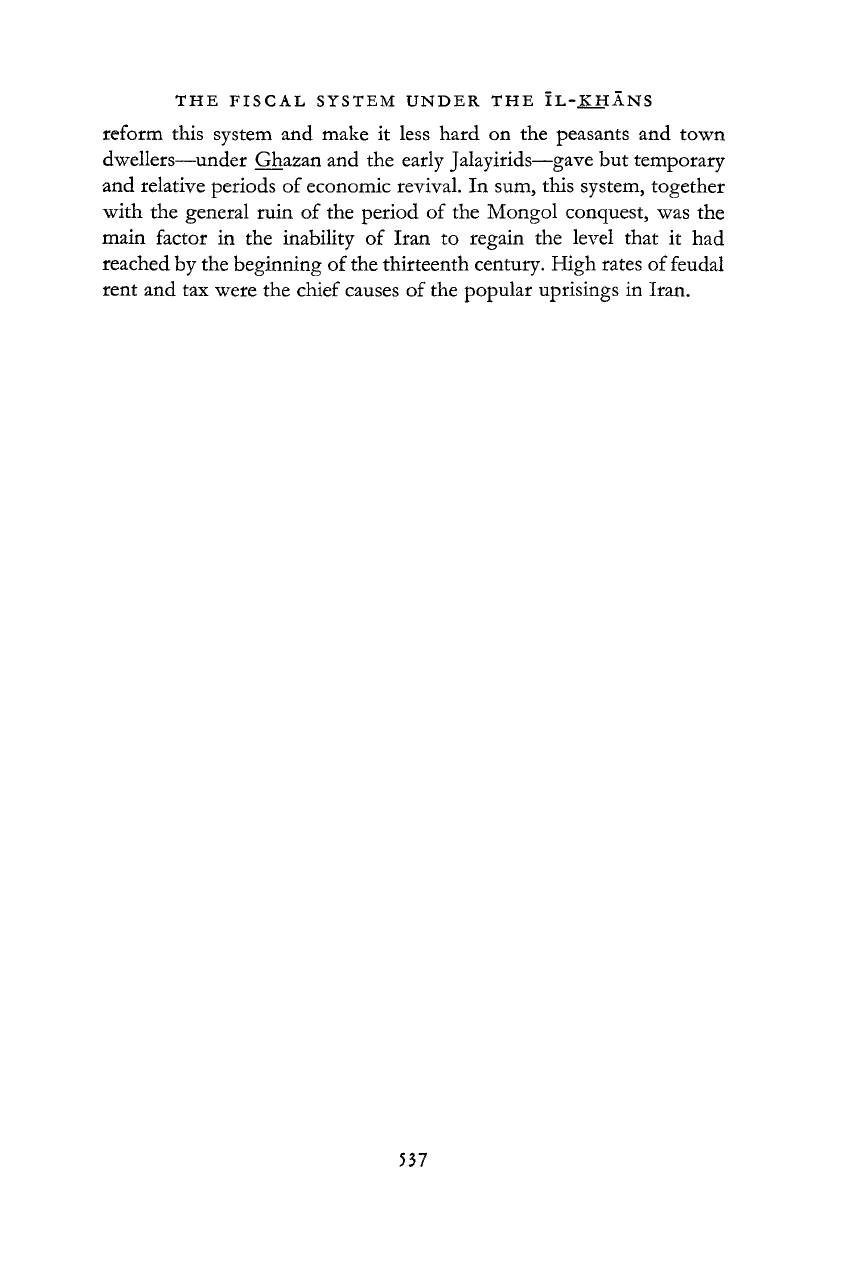
THE FISCAL SYSTEM UNDER THE IL-KHANS
537
reform this system and make it less hard on the peasants and town
dwellers—under Ghazan and the early Jalayirids—gave but temporary
and relative periods of economic revival. In sum, this system, together
with the general ruin of the period of the Mongol conquest, was the
main factor in the inability of Iran to regain the level that it had
reached by the beginning of the thirteenth century. High rates of feudal
rent and tax were the chief causes of the popular uprisings in Iran.
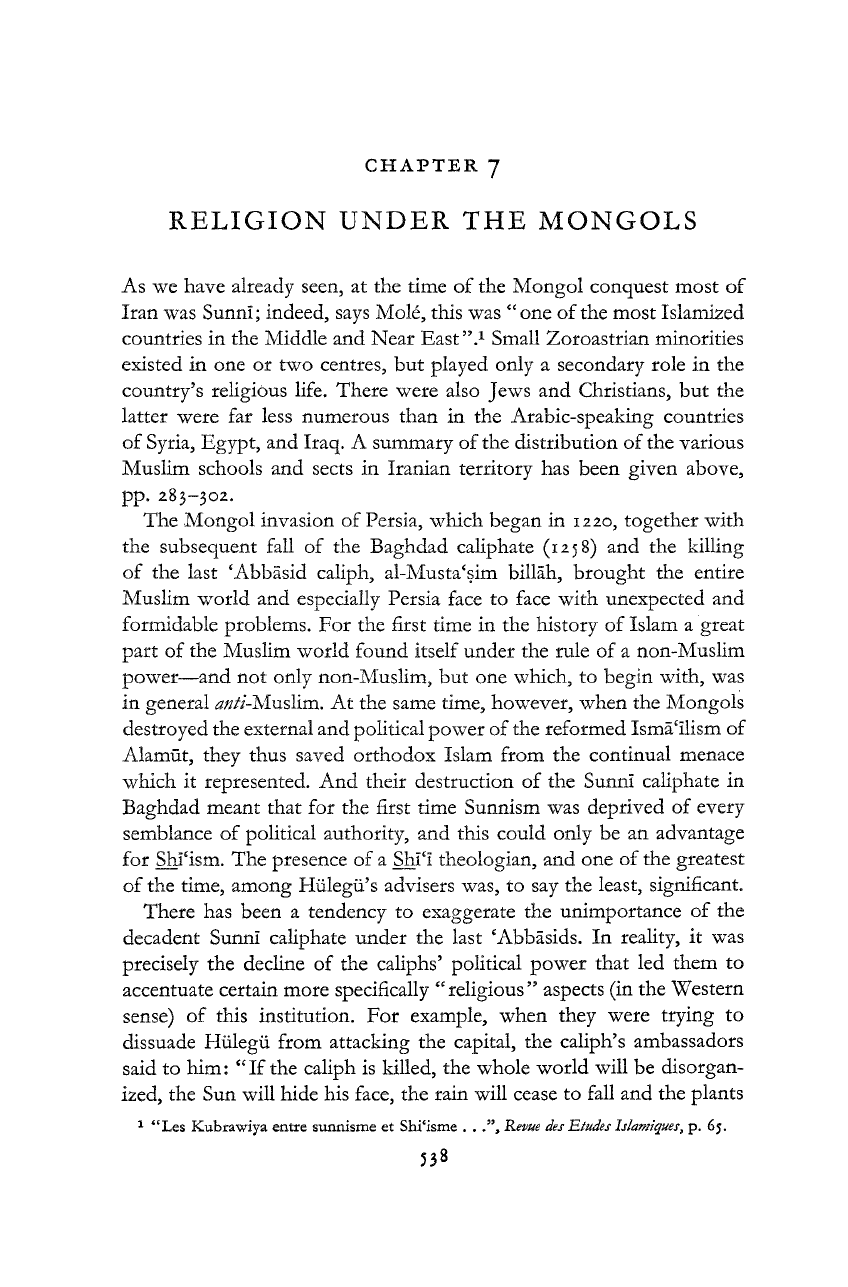
CHAPTER 7
RELIGION UNDER THE MONGOLS
As we have already seen, at the time of the Mongol conquest most of
Iran was Sunni; indeed, says Mole, this was " one of the most Islamized
countries in the Middle and Near East".
1
Small Zoroastrian minorities
existed in one or two centres, but played only a secondary role in the
country's religious life. There were also Jews and Christians, but the
latter were far less numerous than in the Arabic-speaking countries
of Syria, Egypt, and Iraq. A summary of the distribution of the various
Muslim schools and sects in Iranian territory has been given above,
pp.
283-302.
The Mongol invasion of Persia, which began in 1220, together with
the subsequent fall of the Baghdad caliphate (1258) and the killing
of the last 'Abbasid caliph, al-Musta'sim billah, brought the entire
Muslim world and especially Persia face to face with unexpected and
formidable problems. For the first time in the history of Islam a great
part of the Muslim world found itself under the rule of a non-Muslim
power—and not only non-Muslim, but one which, to begin with, was
in general ^////-Muslim. At the same time, however, when the Mongols
destroyed the external and political power of the reformed Isma'Ilism of
Alamut, they thus saved orthodox Islam from the continual menace
which it represented. And their destruction of the Sunni caliphate in
Baghdad meant that for the first time Sunnism was deprived of every
semblance of political authority, and this could only be an advantage
for Shi'ism. The presence of a ShTi theologian, and one of the greatest
of the time, among Hiilegu's advisers was, to say the least, significant.
There has been a tendency to exaggerate the unimportance of the
decadent Sunni caliphate under the last 'Abbasids. In reality, it was
precisely the decline of the caliphs' political power that led them to
accentuate certain more specifically "religious" aspects (in the Western
sense) of this institution. For example, when they were trying to
dissuade Hiilegu. from attacking the capital, the caliph's ambassadors
said to him: "If the caliph is killed, the whole world will be disorgan-
ized, the Sun will hide his face, the rain will cease to fall and the plants
1
"Les Kubrawiya entre sunnisme et Shi'isme . . .", Revue des Etudes Islam iques, p. 65.
538
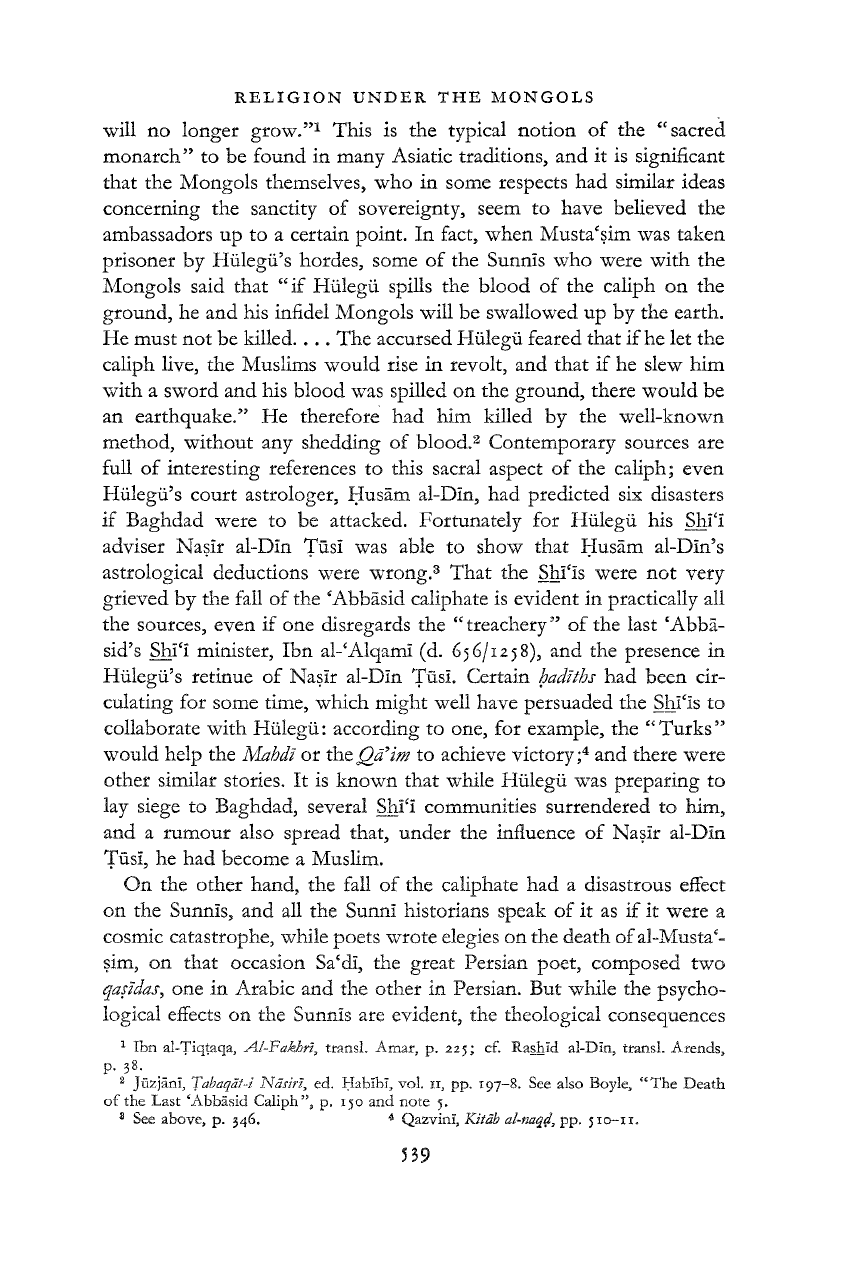
RELIGION UNDER
THE
MONGOLS
539
will
no
longer grow."
1
This
is the
typical notion
of the "
sacred
monarch"
to be
found
in
many Asiatic traditions,
and it is
significant
that
the
Mongols themselves,
who in
some respects
had
similar ideas
concerning
the
sanctity
of
sovereignty, seem
to
have believed
the
ambassadors
up to a
certain point.
In
fact, when Musta'sim
was
taken
prisoner
by
Hülegü's hordes, some
of the
Sunnis
who
were with
the
Mongols said that
"if
Hülegü spills
the
blood
of the
caliph
on the
ground,
he and his
infidel Mongols will
be
swallowed
up by the
earth.
He must
not be
killed..
.. The
accursed Hülegü feared that
if
he
let the
caliph live,
the
Muslims would rise
in
revolt,
and
that
if he
slew
him
with
a
sword
and his
blood
was
spilled
on the
ground, there would
be
an earthquake."
He
therefore
had him
killed
by the
well-known
method, without
any
shedding
of
blood.
2
Contemporary sources
are
full
of
interesting references
to
this sacral aspect
of the
caliph; even
Hülegü's court astrologer, Husâm al-Dln,
had
predicted
six
disasters
if Baghdad were
to be
attacked. Fortunately
for
Hülegü
his
Shi'i
adviser Naşir al-Dln
Tüsi was
able
to
show that Husâm al-Dln's
astrological deductions were wrong.
3
That
the
ShTis were
not
very
grieved
by the
fall
of
the 'Abbasid caliphate
is
evident
in
practically
all
the sources, even
if one
disregards
the
"treachery"
of the
last 'Abba-
sid's
Shi'i
minister,
Ibn
al-'Alqami
(d.
656/1258),
and the
presence
in
Hülegü's retinue
of
Naşir al-Din Tüsi. Certain hadlths
had
been cir-
culating
for
some time, which might well have persuaded
the
Şhfls
to
collaborate with Hülegü: according
to one, for
example,
the "
Turks"
would help
the Mahdl or
the
Q/Tim
to
achieve victory ;
4
and
there were
other similar stories.
It is
known that while Hülegü
was
preparing
to
lay siege
to
Baghdad, several Shi'I communities surrendered
to him,
and
a
rumour also spread that, under
the
influence
of
Naşir al-Din
Tüsi,
he had
become
a
Muslim.
On
the
other hand,
the
fall
of the
caliphate
had a
disastrous effect
on
the
Sunnis,
and all the
Sunni historians speak
of it as if it
were
a
cosmic catastrophe, while poets wrote elegies
on
the death of al-Musta'-
şim,
on
that occasion Sa'dl,
the
great Persian poet, composed
two
qafidaS)
one in
Arabic
and the
other
in
Persian.
But
while
the
psycho-
logical effects
on the
Sunnis
are
evident,
the
theological consequences
1
Ibn
al-Tiqtaqa, Al-Fakhri, transl. Amar,
p. 225; cf.
Raşh îd al-Dîn, transl. A rends,
P-
38.
2
jûzjânî, Tabaqat-i Naşiri,
ed.
Hablbî, vol.
n, pp.
197-8.
See
also Boyle,
"The
Death
of the Last 'Abbâsid Caliph
p. 150 and
note
5.
8
See
above,
p. 346.
4
Qazvinl, Kitâb
al֊naqd,
pp. 510-11.
